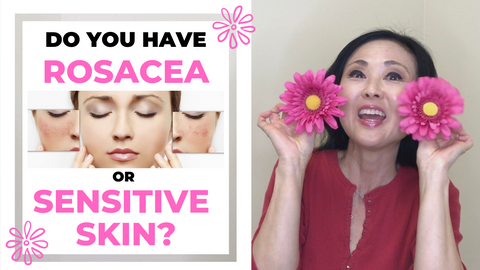Vitamin D and your skin: According to one source (links will be below), 42% of Americans are deficient in Vitamin D and Vitamin D deficiency is also a global problem.
There are 3 main sources of Vitamin D:
-From the Sun (exposure to UVB rays Vitamin d3
-Food sources (namely Fish Vitamin d3) and some plant sources (Vitamin d2)
-Vitamin D supplements
The benefits of Vitamin D is that it can help boost the immune system and also increase the absorption of magnesium, phosphate and calcium.
In this article, we are mainly focusing on Vitamin D and the different types of skin and how it can affect the the amount of Vitamin D levels in the skin.
Vitamin D and Mature , Aging Skin:
One of the factors influencing Vitamin D levels is the older we become, the thinner our skin gets, and the less time we may spend outdoors to receive sunlight. The major source of Vitamin D is UVB induced dermal synthesis of cholecalciferol.
Clinical studies have shown that the older we get, the MORE sunlight we need to preproduce vitamin d3 especially since:
-More than 80% of the previtamin D3 is produced in the skin.
Clinical study showed comparison of Vitamin D3 produced in the skin of:
-8-18 year old subjects
vs
-72-82 year old subjects
Result: The capacity of skin to produce Vitamin D3 can decrease by more than 2 folds
The study concluded that the elderly need more sunlight because they are already lacking in Vitamin D.
Lack of Vitamin D can lead to obesity, diabetes, hypertension, osteoporosis, and a host of other lifestyle related chronic illnesses.
While mature skin needs MORE vitamin D, it also needs LESS of this of nutrient during the post menopausal stage. Too much of this, can actually cause rapid aging in Post Menopausal women.
Vitamin D and Dark Skin:
According to some clinical studies, vitamin D levels seem to be lower in African American and Hispanic groups.
Another source claimed that Fitzpatrick skin type one can produce up to 6 fold the amount of vitamin D that is produced by dark skin types (Fitzpatrick skin type 6).
Darker skin types may need more time in the sun to produce the vitamin d3 and/or it may be even more important that vitamin d3 supplements be part of the regular diet.
Clinical studies found that African Americans and Mexican Americans have consistently shown lower levels of Vitamin D3 than their non-hispanic caucasian counterparts primarily because of the increased skin pigmentation that protects their skin from absorbing UVB rays.
This may inhibit dermal synthesis of cholecalciferol and as a result, may lead to the aforementioned, increased risk of chronic diseases such as:
-Diabetes
-Cancer
-Hypertension
HOWEVER, despite lower levels of Vitamin D, African Americans still maintain higher levels of bone mineral density and less likely to experience bone fractures than their caucasian counterparts.
There was no significant difference in bone mineral density between Mexican Americans and Caucasians.
Vitamin D and Sensitive Skin:
Vitamin D and your skin , especially if your skin is sensitive or your skin has become sensitized due to using photosensitizing ingredients such as Retin A, Retinol, Acne medications such as Accutane, Epiduo, and any AHA, or BHA products can lead to shorter time in the sun due to the skin being more prone to burning from the UVB rays.
In this case, there are only two options:
-To continue using the photosensitizing products and choose to take supplements and avoid the sun.
or
– Choose to discontinue taking the products and slowly increase sun exposure.
Vitamin D and Your Skin: Sun Exposure:
Generally speaking, factors such as:
-Lifestyle
-Age
-The color of your skin
-Medications
-Where you live
can also affect how much time you need to be in the sun. Generally speaking, it is anywhere between 15-30 minutes a day of unprotected sun exposure. One article stated that it could be up to 90 minutes, depending on where you live.
If you are older and/or have darker skin, the more sun exposure you need.
The more susceptible you are to the burning rays, the more you may need to consider including Vitamin D supplements in your diet and eating more foods that are higher in Vitamin D.
Foods higher in Vitamin D:
Wild Salmon has higher amounts of Vitamin D vs Farm raised Salmon. For example, in some testings, the wild salmon had 988IU in a 3.5 ounce serving. This is 124% of the daily value needed. In some wild salmon, some had up to 1,300 IU of vitamin D.
Fatty Fishes such as Mackerel, tuna, sardines, halibut, and even if you can stand it, cod liver oil .
Egg Yolks: 1 egg yolk had 37 IU which is about 5% of the daily value. Eggs that came from pasture raised chickens that were exposed to the sunshine had more vitamin D in their egg yolks than the commercially raised chickens that are kept inside .
If you are vegan or vegetarian, a good plant source of vitamin D2 (ergocalciferol) could be another source of vitamin d. Although in some studies suggested this type is not as effective as the vitamin d3 at raising vitamin D in the blood.
One plant source is WILD grown mushrooms, NOT the commercially grown mushrooms that are grown inside.
PRO TIP:
If you are not sure if the mushrooms you buy ,are grown outdoors, here is a way to increase the vitamin d levels in your fresh mushrooms.
How to Increase the Vitamin D in your Mushrooms:
- Slice fresh mushrooms
- Lay them out on a tray
- Expose them to sunlight for 60 minutes at the very least but preferably during the highest sun exposure times (10-4pm)
- Prepare the mushrooms.
This was done in a clinical study where a subject group ingested the fresh mushrooms that were exposed to sunlight and then they measured the vitamin d serum levels in their blood. At the end of the study, it showed that the vitamin D levels in their blood increased.
Which Mushrooms are Good for Skin
Japanese Seaweed Wakame Nori Kombu
Astaxanthin : Anti aging Benefits for Skin
Stay tuned for more videos and topics related to the health of the skin!
Follow us @;
YouTube Channel: https://www.youtube.com/channel/UC4XGWX6eheTisHo8UBsdOWA
Instagram:@GoSeeChristy
Facebook:https://www.facebook.com/goseeChristyBeautyBoutique/
Twitter:https://twitter.com/goseechristy
Pinterest:https://www.pinterest.com/goseechristy/
Sources:
https://www.cantonmercy.org/healthchat/42-percent-of-americans-are-vitamin-d-deficient/
https://pubmed.ncbi.nlm.nih.gov/26877203/
https://www.ncbi.nlm.nih.gov/pmc/articles/PMC6178567/
https://www.ncbi.nlm.nih.gov/pmc/articles/PMC3093445/
https://www.ncbi.nlm.nih.gov/pmc/articles/PMC4642156/
https://pubmed.ncbi.nlm.nih.gov/15531486/
Beelman, R. & M. Kalaras. “Post-harvest Vitamin D Enrichment of Fresh Mushrooms.” HAL Project# MU07018 (April 30, 2009), Penn State University.



